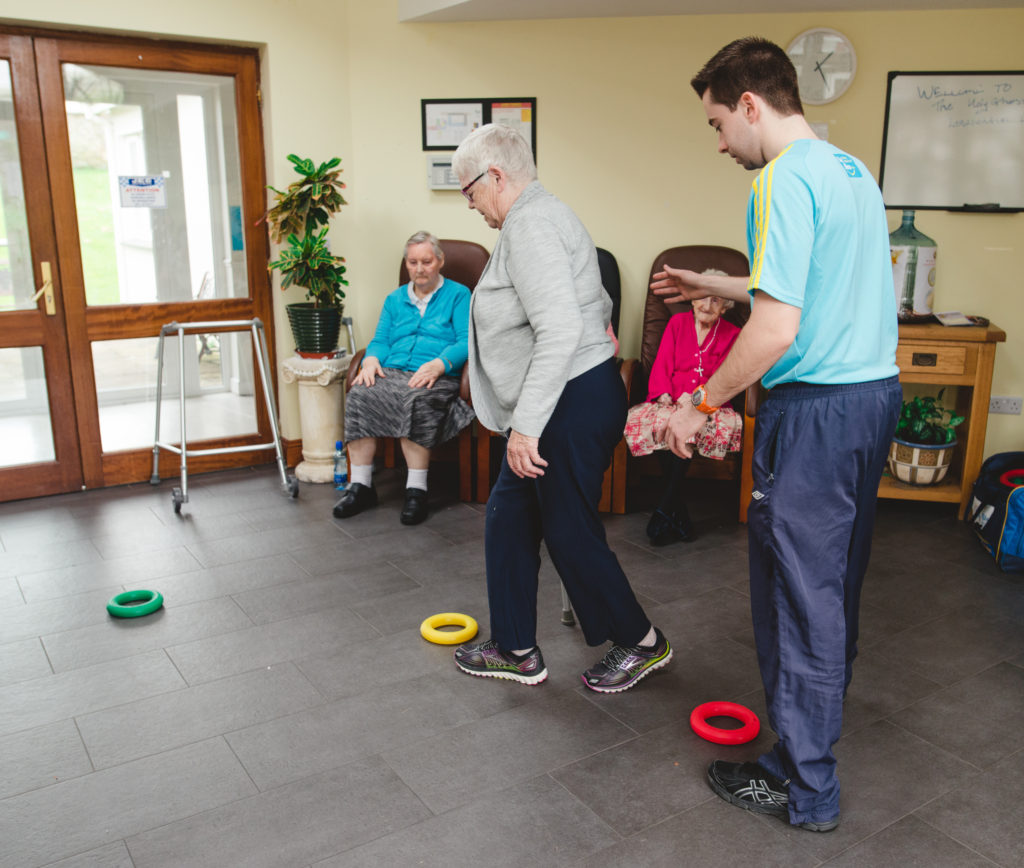This weeks blog post was written by one of our senior physical trainers, Shane. He has outlined a few fantastic exercises to help with fall prevention.
In the last year I have challenged myself to make clients and class participants stand more. When I looked into the increasingly important topic of falls prevention I soon realised how little time many of my older clients actually spend standing or using everyday situations to help prevent falls. Let’s take a standard arm curl exercise. By performing the action in a standing position instead of in a seated position a person can simultaneously work on balance and stability through engaging the core. This weight bearing task in a standing position can help give the confidence to better perform everyday tasks in the home.
It’s not just a case of performing exercises while standing that is of relevance but the nature of the exercises being performed. Leg strengthening and static balance can be a great starting point in building confidence. For example, one can start with exercises such as heel raises or leg curls. Static balance like in the picture below will also help balance and stability – positions such as a one leg stance where one foot is raised off the floor and held with no hand support. This can be done while standing near a counter if confidence is lacking. However, we must increasingly look towards exercises that challenge cognitive function and encompass movements that are multidirectional within our exercise programmes.

(One leg stance – static balance)
When we tackle falls prevention we must not look at elements of our body and movement in isolation but rather the entire process. When working on a current falls prevention programme with my colleagues – which will be coming soon to Siel Bleu Ireland – we took our visual, vestibular and somatosensory systems into account in addition to looking at leg strength and multidirectional cognitive challenges.
We can look at one aspect of falls prevention which may at first seem insignificant – toe strength. Toe strength is the best predictor of falls within the elderly. Mickle et al. (1) discovered non falling older adults have 20% more toe strength over those who fall, while no differences were found between ankle and quadriceps strength. A movement I have been using to gauge toe strength and counter this problem with clients and class participants is the Vele Forward Lean Manoeuvre, as prescribed by Thomas Micahud and illustrated below. This movement teaches strength in a position that commonly leads to falls when we lean or shift forward to reach for an object, or on the initiation of walking. Using this one aspect of falls prevention, we soon realise how something so small can have such a huge part to play in the overall fight against falls. Of course, toe strength alone will not be sufficient to prevent falls, we must look again at all patterns of movement and systems involved.

(Lean forward using only your toe strength and hold the position, press toes into floor and pause for up to 5 seconds in end range. Return to vertical position again pressing toes hard into the floor. The hips and torso should be straight and don’t allow heels to lift off the floor. Perform this exercise up to 20 times daily and introduce weight bearing as you build confidence)
We must ask ourselves if we have ever practised lateral, backwards, or cross over stepping movements or reinforced our ability to move in different directions and deal with a potential loss of balance. Current theory suggests we have an increased reliance on stepping as a strategy to deal with falls (2) but do we have motor memory of performing such movements? Falls prevention should prepare us to deal with the unexpected before it happens, whereas too often we only think about falls prevention after a fall has occurred or when balance becomes a real problem.
We must literally stand up and exercise to fight falls prevention! Seated and static exercises that don’t stimulate us aren’t sufficient to challenge falls prevention as we age. We must think about movements that are functional in dealing with everyday challenges and in different environments. We must practise movements that make us think and makes us step in different directions. We must think about our walking stride, agility and our ability to judge obstacles in the street. Stand up, move and stay strong!
1.Mickle, K, et al., ISB Clinical Biomechanics Award 2009: Toe weakness and deformity increase the risk of falls in older people. Clinical Biomechanics 2009;24:787-79
2.Lateral Stability and Falls in Older People Mark W. Rogers and Marie-Laure Mille Department of Physical Therapy and Human Movement Sciences, Feinberg School of Medicine, Northwestern University, Chicago, Illinois


